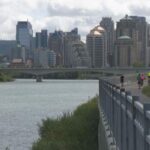As the dust settles over Jasper’s scorched landscape, a new fire has ignited – this one burning through political corridors rather than pine forests. The controversy centers on a wildfire after-action report that Premier Danielle Smith claims unfairly criticized Alberta’s response to the devastating blaze that damaged roughly 30 percent of the historic mountain town last summer.
Walking through Jasper’s partially reopened downtown last week, I spoke with residents still processing both their losses and the political aftermath. “We’re focused on rebuilding, not finger-pointing,” said Marianne Garrah, a local business owner whose shop narrowly escaped the flames. “But we do want honest answers about what happened.”
The dispute erupted after Premier Smith demanded Jasper officials apologize for what she characterized as “misinformation” in their report about provincial firefighting efforts. Smith specifically objected to suggestions that provincial resources weren’t deployed quickly enough when the wildfire threatened the town.
“When someone is accusing my government of not responding appropriately in an emergency, I take that very seriously,” Smith told reporters in Edmonton. “The report contains factual errors about our response that need to be corrected.”
Jasper officials, however, have pushed back against the Premier’s characterization of their findings. In a statement released yesterday, the municipality clarified that the report was never intended to assign blame but rather to analyze response effectiveness and identify areas for improvement.
“We stand by the factual timeline presented in our report,” said Jasper Mayor Richard Ireland during an emergency council meeting. “This was about learning lessons, not casting aspersions.”
The 87-page report, compiled by independent emergency management consultants, details the chronology of the July 2023 wildfire response. It notes that provincial air tankers were requested at 4:37 p.m. on July 22 but didn’t arrive until after 6:00 p.m. – a timeline the province disputes.
Alberta Forestry Minister Todd Loewen countered with provincial records showing aircraft were dispatched within 11 minutes of the request. “Our response was immediate and appropriate given the circumstances,” Loewen stated in a press conference held in Calgary.
For Kevin Van Tighem, former superintendent of Banff National Park and wildfire management expert, the disagreement highlights deeper issues. “These post-disaster reviews often become political because they expose systemic vulnerabilities nobody wants to own,” he told me during a phone interview. “The reality is that climate change is creating wildfire conditions beyond what our current systems were designed to handle.”
Environment Canada data supports Van Tighem’s assessment. Last summer was Alberta’s hottest on record, with precipitation levels 40 percent below seasonal averages in the mountain parks region. Parks Canada recorded 132 lightning strikes within Jasper National Park during the 48 hours before the fire began.
The controversy unfolds against a backdrop of increasing tensions between the provincial government and Parks Canada, with jurisdiction questions complicating wildfire responses in national parks. Under current agreements, Parks Canada handles initial fire response within park boundaries, with provincial resources available upon request.
“When flames are approaching homes, nobody cares about jurisdictional boundaries,” said former Jasper fire chief Greg Van Tighem (no relation to Kevin). “The focus should be on making sure our response systems work seamlessly across those invisible lines.”
For Jasper residents, the political sparring feels disconnected from their lived experience. Chris Staddon, who lost his home of 23 years in the fire, expressed frustration with the controversy. “I don’t care who’s right about exactly what time a plane showed up,” he said. “I care about making sure this doesn’t happen to another community.”
The situation highlights the challenges of disaster management in Canada’s changing climate landscape. A report from the Canadian Climate Institute published last month projects a 50 percent increase in extreme wildfire conditions across Western Canada by 2050, requiring significant adaptation of emergency response systems.
Premier Smith has announced plans to increase the provincial wildfire fighting budget by $75 million this year and expand the fleet of air tankers from 7 to 10 by 2025. Meanwhile, Parks Canada has committed $42 million toward enhanced wildfire prevention measures in mountain parks, including expanded firebreaks around townsite perimeters.
As Jasper begins its long recovery process, with reconstruction expected to take 3-5 years, the community remains united despite the political controversy swirling around them.
“Jasper strong isn’t just a slogan on T-shirts,” Garrah told me as we watched workers clearing debris from a former hotel site. “It’s how we’re approaching everything now – rebuilding together, learning the hard lessons, and preparing for a future where these extreme events might become more common.”
For now, the municipality has declined Premier Smith’s demand for an apology but has offered to meet with provincial officials to clarify specific points of disagreement in the report. Whether this olive branch will douse the political flames remains to be seen.






